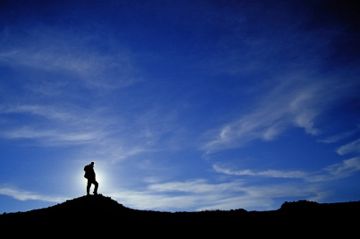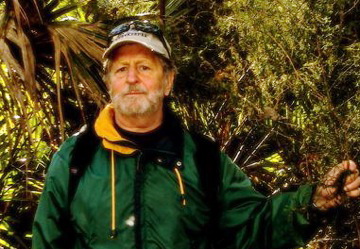Why I Walk
Speaker's Corner: No, it's not quick or expedient. But it offers something other modes of transport can't. Bill Belleville on traveling by foot.
04.29.10 | 10:57 AM ET
 iStockPhoto
iStockPhotoI grew up in a home on a dirt street. One day, the street would be paved and the few houses would turn into a neighborhood. But this was still the country, and things happened slowly.
There was a corn field behind our home, and behind that, a state farmers market and several packing houses. In the summertime, in my early teens, I would make a few extra bucks loading watermelons onto tractor trailers from the smaller flatbed and pick-up trucks the local farmers used to bring their crops to market.
My neighbor Rick and I walked miles out into the countryside, zigzagging across farm fields, through isolated tracts of woods with little streams coursing through them, and down long winding roads under thick canopies of hardwoods. Sometimes, we would see old farm homes hidden back away in the forest; sometimes, we would pass open pastures with horses, maybe a few cows. We seldom carried a backpack or snacks, or even canteens of water. We had no stated intent except to explore. The notion of “hiking” sounded too planned and organized; our treks were simply long and extended walks.
I was intrigued by bugs then, and had even bought a book about them. Sometimes, I would find strange ornate bugs, like rhino beetles, and if they were dead, I’d bring them home to put in little dioramas I made for them out of shoe boxes. I knew the most common birds: sparrows and robins, and sometimes cardinals and starlings. Rarely, I saw a great blue heron hidden down in a little thickly wooded creek that spilled out of a lake. In early fall, Canada geese and snow geese would migrate, flying over in V formations. Their cries were haunting, even then, since they meant for me the end of warmer, boy-friendly summer weather, and the beginning of the cold season. But they were harbingers, too, marking time visually.
I knew the names of some of the fish, since we had an intimate relationship with them from the other end of a fishing line. There were striped bass, which we knew as rockfish, and spot and catfish. In tidal creeks, there were blue crabs swimming through; sometimes there were “doublers” in which the larger “Jimmy” male held onto the molted, soft shelled female as they mated. Instinct for that was so strong they held fast even when we scooped them up with long-handled nets and dumped them into bushel baskets. We ate the crabs, steamed with Old Bay seasoning and dry mustard sprinkled on them, and Mom cooked the rockfish, usually with strips of bacon and with butter. For most who grew up in the country, wildlife could also mean food; it was no different for our family.
We roamed the countryside, Rick and I, because we felt a need to do so. There was nothing for certain we were ever sure we would find, but we always looked for new ways of seeing, for new things to see. Following creeks upstream was an act full of discovery since they always led to lakes and the lakes to more streams, each with its own wooded furrows cut into the earth. Sometimes, I carried a knife in a sheath, but I never had anything to use it for.
 The author (Photo by Leslie Kemp Poole)
The author (Photo by Leslie Kemp Poole)Later as an adult, I read Thoreau’s essay Walking. In it, he described his own long walks as “sauntering,” a word derived from “idle people who roved about the country, in the Middle Ages, and asked charity ... under the pretense of going a la Sainte Terre, the Holy Land.” In the best sense, said Thoreau, those “saunterers” with no homes to return to were unafflicted by material concerns, and that is the secret to successful sauntering. Every walk then becomes a crusade to reconquer this natural Holy Land from the hands of the infidels who would exploit, debase, and alter it.
When I started walking as a boy, our family lived on a peninsula, the flat slab of land that held the Eastern Shore of Maryland, a spit of Virginia, and all of the state of Delaware. We had strong territorial country prejudices, and thought of Delaware and Virginia as states not hardly worth knowing about. But that peninsula isolated them as it isolated us, almost as fully as an island. As a very young boy, I remember riding a long ferry across the choppy Chesapeake to get to Baltimore to the west, since there was yet no bridge across the Bay. We did the same to the south, where a much longer bay-bridge tunnel system eventually spanned the great mouth of the Chesapeake.
The ferries had kept us safe in so many ways, had kept anyone from driving over a bridge just because they wanted to. Taking a ferry required time and money, and it was a wondrous deterrent to expediency. Paul Theroux once wrote that the best places are found at the end of the worst roads, since the challenge of the travel restricted mass accessibility. A slow ferry boat did the same. Later, when bridges replaced the ferries, we—except for a few old timers—welcomed them. We had absolutely no idea of the cultural and environmental impacts this new accessibility would eventually have on the integrity of our long-ignored “Shore,” a place Harper’s magazine a hundred years earlier had called “the last peninsula of the Lost and the Vague.” Collectively, our “tribe” became diluted, our accents washed out, our behaviors less certain, more influenced by the outside world beyond the Bay. And then the great new mass of people living in the watershed of the Bay gradually begin to transform it.
Even as the tidewater nature of Shore living infused nearly every moment of my life, I took it for granted, expecting it to always be there. But now, with all the decades in between for perspective, I miss it terribly, and I miss the speciated and passionate people the Shore had once created. Accessibility spelled an end to most of them, just as it did to the wide open countryside. Now when I think of my life as a young boy approaching manhood, I can imagine no place finer to have lived than under the broad skies over the flat terrain carved by the tidal rivers and creeks on the lower Eastern Shore.
I think now of those geese flying south for the winter, and instead of having an image, I hear those soulful, primal sounds they left in their wake as they soared across the broad winter Shore sky. As a boy, I was wistful for all that the flight of those birds took with them when they left, and I am wistful now.
And so, I keep walking through nature in Florida where I now live, or through tropical landscapes in Latin America and the Antilles where I visit. My walks take me for miles through the cypress hammocks and pine flatwoods and—overseas—in rainforest jungles and across grassy savannahs. Sometimes I encounter black bear and feral hogs, sometimes indigo snakes longer than I am tall. Sometimes I see gators and caimans on the shores of rivers, sometimes swallow-tailed kites and frigate birds overhead. I walk with like-minded souls, or I walk by myself. In our technologically obsessed world, I set out on foot in defiance of the quick and expedient. On some level, I become a saunterer in my own crusade to recover the Holy Land from the hands of the Infidels, to realize my own hope for a true and authentic world.
I walk to discover new things, and to remember in my heart the ones I once found. I walk in celebration of discovery, and in the evocation of real people and place. I walk to remember.![]()
Frank 04.30.10 | 6:29 AM ET
Totally agree. As Werner Herzog says, “Tourism is sin, and travel on foot virtue.”
Cecille 04.30.10 | 2:42 PM ET
Splendid work. Nice writing there. thanks for sharing and keep up the good wor
Sorrento 05.01.10 | 8:28 PM ET
Great! I like this post very much and I love nature. Thanks for sharing your walks:)
Lubna 05.02.10 | 2:14 AM ET
Very well written, Bill. Each and every sentence seemed to spring to life. It reminded me of my childhood days, when the busy city of Mumbai was different and there were enough (if not ample) spaces to explore and be one with nature.
In fact, some days ago, I captured a wee bit of these experiences on my blog post.
http://writerscyberslate.blogspot.com/2010/03/fern.html
soultravelers3 05.12.10 | 6:56 AM ET
Thank you Bill, beautifully said! I couldn’t agree more…most of our open ended world-tour as a family as been by foot. Walking the land is so important to us and I’m grateful that my daughter is learning this at such a young age.
Bill Belleville 05.12.10 | 7:45 AM ET
Thanks to all for the very kind comments on my story. Best of luck to everyone in their walks, hikes, and saunters—-wherever they lead you.
Stay in Kumaon 05.17.10 | 3:54 AM ET
My friends and myself have decided to go on a walking get away next month. it will be a 40kms walk. since its our first one we hope to get it right :D